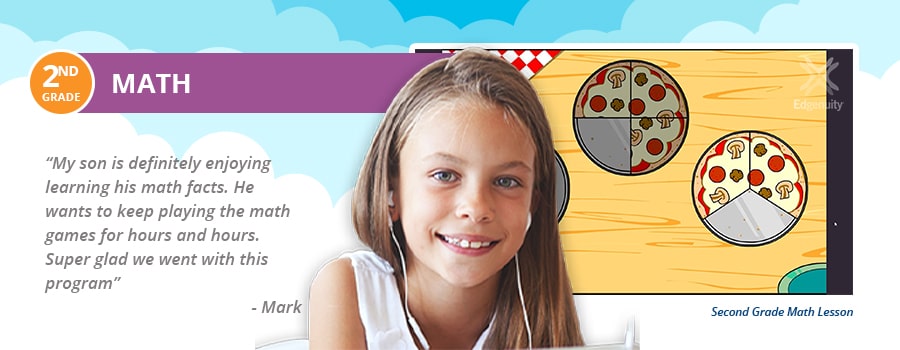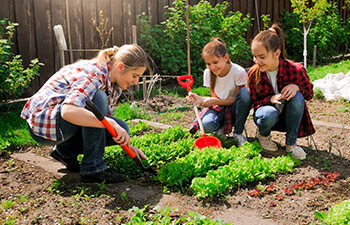Second Grade Online Math Curriculum
Time4Learning understands how important the choice of a second grade math curriculum is for families. Not only is second grade a time to review the foundational skills learned in first grade math, but it is a launchpad for multiplication and for understanding how numbers are used in everyday life.
The major math strands for second grade curriculum are number sense and operations, algebra, geometry and spatial sense, measurement, and data analysis and probability. Time4Learning teaches a comprehensive second grade math curriculum using fun, activities to build a solid math foundation.
What Math Should a Second Grader Know?
By the time they have finished first grade, students have begun to understand the relationships between numbers and have started to recognize mathematical patterns. Second graders become adept at one and two-digit addition and subtraction and have learned a variety of methods for solving mathematical problems.
Some of the key math concepts a second grader should know include:
- Read and write numerals to 100 and to count objects to 100 or more
- Addition and subtraction of two-digit numbers without regrouping, up to 100, using models and algorithms
- Explore number patterns on a hundred chart and with a calculator
- Combine shapes to form others shapes and find geometric shapes in real-life situations
- Learn and compare money values including the quarter (25 cents), half-dollar (50 cents), and dollar (100 cents)
The ideal math curriculum for second grade will continue to build on these skills and expand on to new ones while making learning fun and motivating them to continue to learn.
Second Grade Math Objectives
In second grade, students continue with more sophisticated approaches to addition and subtraction and begin understanding the patterns leading to multiplication. Simple fractions are also introduced this year. Geometric learning extends a student’s understanding of shapes and their parts.
Some of the key goals for second grade math include:
- Understanding the meaning, uses, and representations for numbers
- Computing addition and subtraction facts accurately
- Analyzing and interpreting data
- Using appropriate techniques, tools, units, and formulas in making measurements
- Investigating the properties and characteristics of two and three dimensional geometric shapes
Time4Learning’s Second Grade Math Scope & Sequence
Count and group objects into hundreds, tens, and ones. Identify a given number in expanded form. Identify the value of a given digit within a number up to the hundredths place.
Read and write number words up to ninety-nine and match them to numerals.
Compare and order numbers using symbols such as <, =, and >. When given any number up to 1,000, identify one more than, one less than, 10 more than, 10 less than, 100 more than, and 100 less than.
Read and understand ordinal numbers 1st – 100th. Identify ordinal number words first – tenth by name.
Using diagrams, pictorial representations, and numerical expressions, represent equivalent forms of various numbers up to 1000.
Count up to 1000 by fives, tens, twenty-fives, fifties, and hundreds using mental math and pictorial representations.
Use zero as a placeholder and identify 10 tens as 100, 10 hundreds as 1000.
Locate numbers up to 1000 on a number line. Use a number line to round numbers to the nearest 10.
Identify odd and even numbers.
Locate numbers up to 1000 on a number line. Use a number line to round numbers to the nearest 10.
Chapter Test: Number Sense
Identify, model, and record fractions that represent more than one equal part of a whole.
Identify, model, and record equal parts of groups.
Identify words for fractional parts such as halves, thirds, quarters, and eighths and fractions representing 1 whole.
Solve addition and subtraction facts up to 18 by using inverse operations. Describe the related facts that make up a fact family.
Use the Associative Property of Addition to solve addition problems involving three addends.
Solve addition problems involving two-digit numbers with regrouping.
Add single- and two-digit whole numbers.
Solve subtraction problems involving two-digit numbers with regrouping.
Subtract single-digit numbers from single and two-digit numbers and two-digit numbers from two-digit numbers.
Identify multiplication as repeated addition. Multiply two one-digit numbers by 2, 3, and 5 using an array.
Explain division as equal parts of a set. Divide a number up to 30 by 2, 3, or 5 using pictorial representations.
Estimate reasonable answers to addition and subtraction problems with sums to 100.
Identify pennies, nickels, dimes, quarters, and half-dollars and their values. Count pennies, nickels, dimes, and quarters up to 50¢.
Count mixed collection of coins.
Model the same amount in more than one way. Model an amount using the fewest coins.
Solve addition and subtraction problems involving money, with and without regrouping.
Sort objects by attributes of shape, size, or color. Recognize and explain how patterns are made (e.g. repetition, transformation, or other changes to attribute).
Sort objects using Venn diagram with one intersection.
Describe a given pattern and explain the pattern rule.
Predict, extend, and create patterns that are pictorial or symbolic. Transfer patterns from one medium to another (e.g., change red, red, blue, green, red to 1,1,2,3,1).
Compare repeating and growing patterns and analyze how they are generated.
Identify patterns in the real world such as repeating, tessellating, and patchwork.
Identify number patterns on a hundred chart.
Predict and extend a linear pattern.
Use the Commutative Property of Addition to solve problems. Check the sum by changing the addends. Solve two-digit equations with one unknown.
Use pictorial representations and numbers to explore equalities and inequalities.
Solve number sentences with equalities and inequalities using the symbols <, =, >.
Using models, pictures, and algorithms, solve problems involving the addition and subtraction of two-digit numbers with and without regrouping.
Solve real-world addition and subtraction equations with one unknown.
Create models that explore the concept of an equation being balanced.
Describe and create plane shapes such as squares, rectangles, triangles, hexagons, trapezoid, and parallelograms.
Describe and create solids shapes such as cubes, rectangular prisms, spheres, cylinders, cones, and pyramids.
Describe, classify, and sort two- and three-dimensional shapes according to their attributes (sides, corners, faces, curves). Explain which attribute is being used for classification.
Identify plane shapes as faces of solid shapes.
Identify similar and congruent two-dimensional objects.
Identify lines as parallel or perpendicular.
Identify lines as horizontal or vertical.
Identify, locate, and move objects according to positional words such as to the left, above, and behind.
Identify the location of objects according to two directions such as upper-right, upper-left, lower-right, and lower-left.
Locate objects on the first quadrant of a coordinate grid.
Locate, plot, and identify known and unknown numbers on a number line from 0 to 50 by twos and from 1 to 100 by fives.
Identify and demonstrate slides, flips, and turns using pictures.
Recognize congruent figures under slides, flips, or turns.
Match, predict, and identify the reflection of a two-dimensional shape.
Identify and create figures with line symmetry.
Identify and create vertical and horizontal lines of symmetry.
Chapter Test: Using Shapes
Separate or combine plane shapes to create new plane shapes.
Explore perimeter and area of two-dimensional shapes.
Identify area as the number of squares it takes to cover a plane object.
Chapter Test: Spatial Sense
Tell time to the hour and half hour on analog and digital clocks.
Tell time to the nearest quarter hour using digital and analog clocks by counting time in five-minute intervals.
Describe time as A.M. or P.M., identify noon and midnight, and solve simple problems of elapsed time.
Identify relationships of time, such as seconds in a minute, minutes in an hour, days in a week, and months in a year.
Identify names of the months in order and their lengths and identify appropriate tools for measuring time.
Measure and compare lengths using nonstandard units and describe lengths in terms of shorter and longer.
Recognize the need for a standard unit of measure and measure and estimate length to the nearest inch, foot, and yard.
Estimate, compare, and measure distance in feet or miles and choose appropriate unit of measurement for various distances.
Explore perimeter of squares and rectangles by adding lengths of sides.
Recognize that the metric system is another system of measurement and measure length to the nearest centimeter or meter.
Sort and classify objects according to their weight and describe objects in term of lighter, heavier, less than, and more than.
Measure and compare weights using nonstandard units and recognize the need for a standard unit of measurement.
Estimate and measure weights in ounces, pounds, and tons and choose the most reasonable measurement of a specific item.
Recognize that the metric system is another system of measurement and measure weights to the nearest gram or kilogram.
Sort and classify containers according to their capacity. Describe capacity in terms of emptier, fuller, less than, and more than.
Measure and estimate capacity to the nearest cup, pint, quart, and gallon.
Choose appropriate tool for measuring capacity.
Recognize that the metric system is another system of measurement. Measure capacity to using liters and milliliters.
Describe temperature of the seasons in terms of cool, cold, warm, and hot.
Compare Fahrenheit and Celsius thermometers.
Read a Fahrenheit and Celsius thermometers to tell temperature to the nearest two degrees. Relate reasonable temperatures to the seasons.
Chapter Test: Temperature
Create and interpret tally tables.
Collect, organize, and record data into 3 or more categories.
Organizes data into simple graphs such as pictographs and bar graphs.
Transfer data from a chart of two or three categories to a bar or picture graph.
Identify and interpret information such as range, mode, and median from a graph or chart.
Interpret data to make predictions about events or situations.
Identify whether an event is certain, possible, or impossible.
Identify the likelihood of a mathematical event as less likely, likely, or more likely to occur.
Make predictions based on data from activities of chance such as coin flips and spinners.
Chapter Test: Probability
Why Choose Time4Learning Second Grade Math Homeschool Curriculum
Time4Learning’s award-winning program is flexible and easy to use as a second grade core homeschool curriculum or for supplemental enrichment. Our program offers families an affordable and engaging way to help students gain the core mathematics skills they need in second grade, and prepare them for third grade math.







